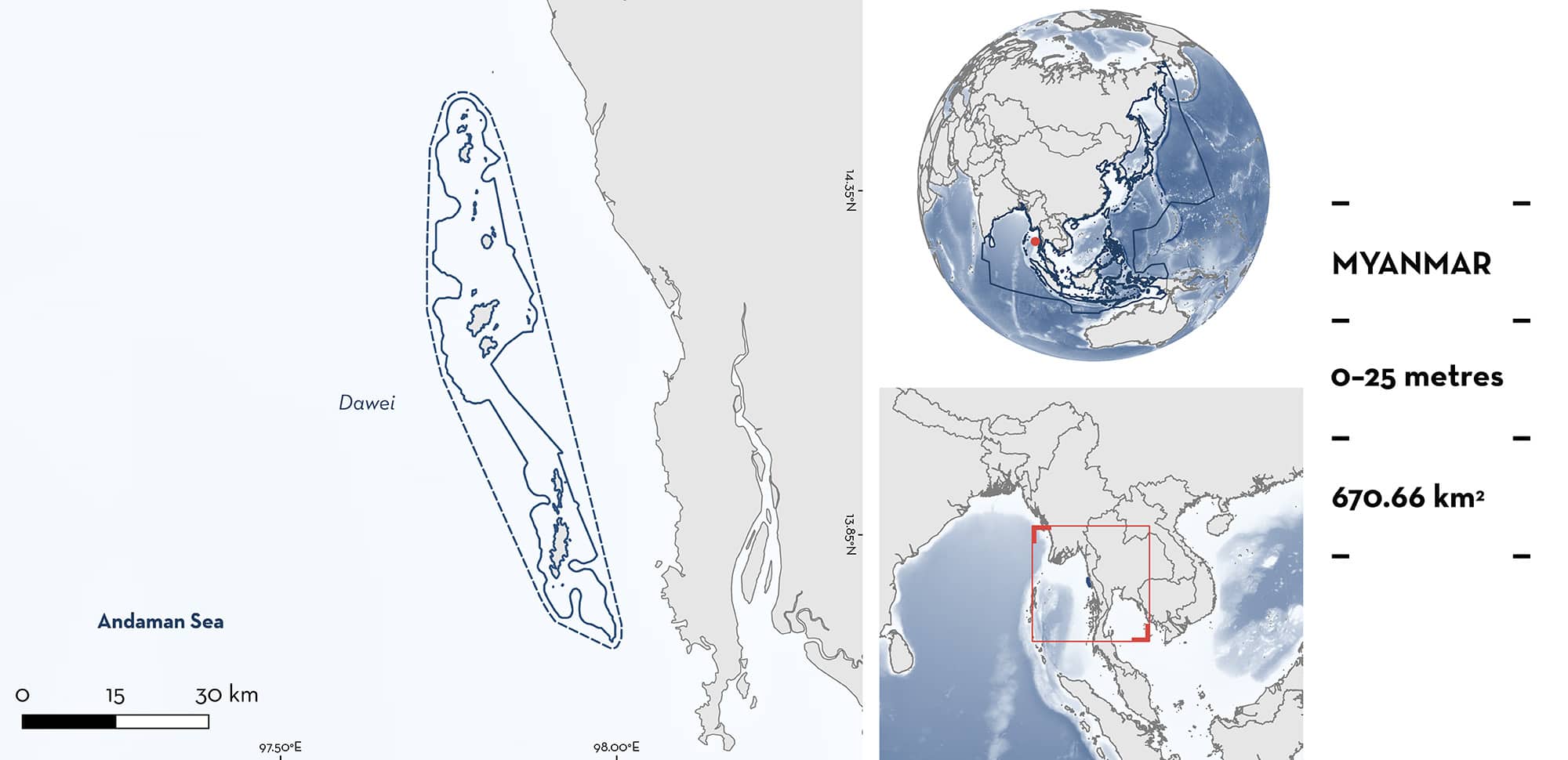ISRA FACTSHEETS
ISRA FACTSHEETS
ASIA REGION
Dawei
Summary
Dawei is in the northern part of Tanintharyi State, off the south coast of Myanmar. It consists of two island groups: MaungMaGan Islands and Moscos Islands. The waters around the islands are characterised by mangrove forests and coral reefs. The area overlaps with the Moscos Kyun Key Biodiversity Area. Within this area there are: threatened species and reproductive areas (Bull Shark Carcharhinus leucas).
Download factsheet
Dawei
DESCRIPTION OF HABITAT
Dawei is located off the northern coast of Tanintharyi State in southern Myanmar. The area consists of two chains of island groups known as MaungMaGan Islands and Moscos Islands. The islands are surrounded by coral reefs and mangrove forests (Beffasti & Galanti 2011). The area is located in the Bay of Bengal and is influenced by the boreal summer monsoon (May–October), which sees higher precipitation levels throughout the region (Xing et al. 2016).
The area overlaps with the Moscos Kyun Key Biodiversity Area (KBA 2024).
This Important Shark and Ray Area is benthopelagic and is delineated from inshore and surface waters (0 m) to 25 m based on the bathymetry of the area.
CRITERION A
VULNERABILITY
The one Qualifying Species within the area is considered threatened with extinction according to the IUCN Red List of Threatened Species. The Bull Shark is assessed as Vulnerable (Rigby et al. 2021).
CRITERION C
SUB-CRITERION C1 – REPRODUCTIVE AREAS
Dawei is an important reproductive area for one shark species.
Fisheries monitoring surveys were conducted at two landing sites (Thabawseik and MaungMaGan) in Dawei during December 2018, May 2019, and December 2019 (Khine et al. 2020). Fishers indicated several locations within the area where Bull Sharks were caught (Laung Lon Islands, Bok Island, MaungMaGan Islands, and Nghet-Theik Island). Bull Shark landings were higher at the start of the summer monsoon season (May–October). A total of 45 individuals were recorded during the study measuring 45–120 cm total length (TL). Thirty-one of these individuals fell within the size range of 45–95 cm TL, indicating neonate or young-of-the-year (YOY). Size-at-birth for this species is 56–81 cm TL (Ebert et al. 2021), with YOY are considered between 69–98 cm TL (Heupel & Simpfendorfer 2011).
Local ecological knowledge (LEK) of fishers indicates the landings of this shark species in Dawei have been recorded over at least ten years, with neonates and YOY being regularly incidentally captured (Howard et al. 2015). Training workshops conducted for shark landing surveys in February and May of 2015 also recorded neonate and YOY Bull Sharks (Howard et al. 2015).
The importance of this area for reproduction in Bull Sharks is supported by the relatively low number of observations of neonates and YOY at landings sites in other parts of Tanintharyi and southern Rakhine (T Ko Gyi pers. obs. 2024). Larger individuals (>100 cm TL) are also observed in northern Rakhine (T Ko Gyi pers. obs. 2024), but Dawei is the only area in Myanmar with regular sightings of neonates/YOY.
Download factsheet
SUBMIT A REQUEST
ISRA SPATIAL LAYER REQUEST
To make a request to download the ISRA Layer in either a GIS compatible Shapefile (.shp) or Google Earth compatible Keyhole Markup Language Zipped file (.kmz) please complete the following form. We will review your request and send the download details to you. We will endeavor to send you the requested files as soon as we can. However, please note that this is not an automated process, and before requests are responded to, they undergo internal review and authorization. As such, requests normally take 5–10 working days to process.
Should you have questions about the data or process, please do not hesitate to contact us.


